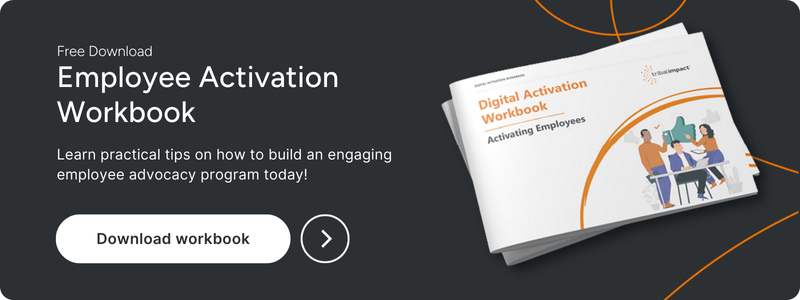76% of people are more likely to trust content an individual shares over content shared by brands (Source: Adweek).
And people want to hear from experts – 90% of B2B buyers engage with a thought leader in their industry (Source: Statusbrew).
In a recent LinkedIn Live, Sarah chatted to Nada Alkutbi, Geo-Social Media Lead at IBM. They discussed the successes and challenges of employee advocacy at IBM.
You can watch Nada's top 5 lessons in employee advocacy in the video below, or read the full summary of what they discussed in this blog.
Why Is Employee Advocacy Important?
81% of consumers report social posts from their peers directly influencer their purchasing decisions (LinkedIn) and 64% of employees who participate in advocacy programs say it helps them create business opportunities (hingemarketing.com).This is because it helps them deepen relationships with clients and partners. It also expands their networks and positions them as thought leaders.
Nada explains that employee advocacy leverages employees’ voices to amplify and champion IBM, its products, and its solutions, through their personal channels. This results in authentic thought leadership from subject matter experts.
Advocacy puts a face and name to the culture within IBM’s brand. It humanises it.
The Three-Tier Approach
Since it’s impossible to offer everyone one-to-one support, Nada segments IBMers into different tiers to offer them different levels of support:
- Tier 1 – This is primarily executives and senior leadership. Marketing and comms support them with their social media strategies based on their visibility plans and social media goals.
- Tier 2 – This is mainly influencers. Those advocates who do social media well and are socially active. They may just need to be included in an advocacy program for some coaching. Usually, this group is made up of subject matter experts, sellers, thought leaders, and event speakers.
- Tier 3 – This is anybody who wants to be an advocate and is looking for on-demand resources.
People often move between the tiers. Employees have reached out to Nada before and said they’re an expert in a topic and would like some coaching or support to help them grow their brand. They’re then moved to the second tier of IBM’s employee advocacy program.
How To Get Leaders To Manage Their Social Media Themselves
Nada said to focus on the executives who want to do it because it has to come from them. Be there to support and coach, but remember they need to do it themselves.
Nada recommended:
- Start with why. What’s in it for them? Why is it important for the brand?
- Share examples. Internal or external ones. Statistics can also help, as data shows people want to work for leaders who are socially active.
- Show them what good KPIs look like. How you’ll track and measure their performance over time.
Then:
- Audit their profile. You can’t jump into creating content and being a thought leader if your profile isn’t complete.
- Work on a visibility plan. What do they want to be known for? How will they build out that content?
- Get them to listen and engage with content in their feed until they’re comfortable creating their own social posts and blogs.
How To Inspire Employees To Create Content
Be clear on what you want employees to amplify and share.Employees shouldn’t feel obliged to share content from company pages. They should want to do it.
IBM makes it easy for employees to find content, but it’s up to them what they share. It has to be authentically in their voice. If the content is great, employees will want to share it.
Sarah’s found that employees love sharing peer-generated content.
And she believes that employees will eventually be content creators in their own right – and brands need to be ready for that.
Using Events For Content Inspiration
Sarah referenced a video that Nada put together for Think Riyadh in Saudi Arabia last October, an event which Nada led the social strategy for.She filmed everything, then, when she got back, she put together a script based on the key highlights and combined it with the visuals. Her colleagues helped her turn that into a TikTok video, then she got approval from the leadership team and VIP guests to post it to the official IBM TikTok.
She also reposted it to LinkedIn. And it really resonated with people.
But she didn’t mind if it did well. It was about taking a risk and experimenting.
To get employees to go one step further with their content, you need to be supportive and encouraging. They need to feel comfortable on social media to post.
Employee Advocacy Is Powerful
Employee advocacy can provide more business opportunities for you and your employees. But it starts at the top – leaders need to set an example by being active on social themselves. Employees will then see this example and want to replicate that success.Creating a culture where employees feel comfortable on social media is important, as that’s when they’ll be more likely to post and see results.
Unlock the power of employee advocacy with our employee advocacy program. Get in touch today to find out more.

